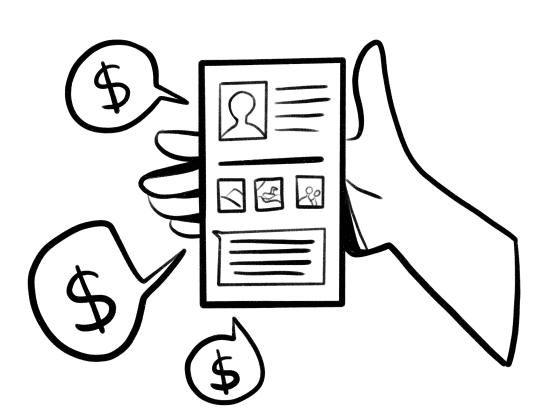Simple math of social media
Simple math of social media.
What does the morning begin with?
Light breakfast – 5$,
Hygiene procedures – $1,
Shaking hands with your neighbor – out of charge
Let’s say, we paid 6 dollars, having barely managed to leave the bedroom.
What awaits us next:
Journey to work – $10,
Lunch with colleagues and discussion of news – $20-30,
Winking at the secretary in the hope of something further – free of charge
It cost us $30 to leave the house.
After that, our plan is:
A night walk around the city – $75.
Going to a store – $100.
A bottle of wine – 12 dollars.
Shaking hands with your neighbor – free of charge
Leaving the office was the most expensive activity of the day, costing us a whopping $187.
With this, we could stop the calculation of expenses for the day and end the article with some capacious phrase on the topic of values and prices. But this article is not about economics, although the information contained in the article is directly related to prices and values.
Let’s go back to the morning – a light breakfast, a shower, hygiene procedures… and something that no morning can do without – scrolling through the news feed on your favorite social network. Should we add this to the expenses or is any post on social networks free?
We spend our time on Facebook, Instagram, Reddit, Twitter and other social networks, and at the same time bring profit to the Internet provider. Is this the price for a post?
We see advertising, the company placing the advertising gets its own royalties, is a cost hidden here? Or do we pay by buying a premium account and thus enriching the network? This smooth road has large pitfalls, and although they are not obvious, we have a very obvious price to pay for these pits.
And again let’s go back to the beginning.
What happens when we install a social network application on a smartphone or tablet? The application requests permission to use our contact book, device memory, listen to the microphone, track local traffic, requests access to GPS, access to the camera and, for some reason, to the accelerometer – a sensor that also determines the angle of inclination of the device.
So, installing a social network means sharing contacts, device identifiers, some habits and geolocation. And here you can start thinking about the price.
We fill out a profile, actively subscribe to friends and make the first publication with a photo. We give access to where photos are stored on the phone and to our own photos.
We write a post, while simultaneously teaching the algorithm the speed of our writing, the peculiarities of text entry and errors. This is necessary so that the algorithm can immediately determine that an unauthorized user is using your account, if suddenly your social network ends up in the hands of attackers. Is this necessary for the algorithm to recognize user behavior?
Aren’t we giving too much for a post with a photo of a tree and the text: “This is the biggest tree I’ve ever seen” and for an online friendship with a neighbor with whom we can shake hands for free?
The post is successfully published. Now you can entertain yourself by going to the secretary’s page, hoping for something further. She actively talks about her life story and actively adds hashtags with locations. You follow the link, but it doesn’t let you go. It tracks your activities across internal applications and third-party sites.
As it turned out, in 2018, the most popular social network in the world collected and later traded the personal data of its users. The exact amount was not disclosed, but the world community estimated the fine for such behavior of the company in 2020-2021 at a total of $6 billion. There are about 3 billion users around the world under the wing of this social network. If you perform a simple mathematical calculation, you will get a figure of 2 dollars.
The platform paid 2 dollars for the information about the actions of literally the HALF of the globe, having learnt mobile connection speed, information about the Wi-Fi environment, screen position, GPS locations, tracking actions in internal applications and on third-parties sites (including sites for medical purposes), as well as for collecting information about all external applications installed on the device.
A year of your activity on the most popular social networks costs 2 dollars. And there are many other, no less intriguing social networks and applications that can track almost every move of yours. But a significant nuisance for each user, however, is, for sure, trade of data, since the combination of different databases can create an “explosive mixture” that is very dangerous and unstable.
Let’s go back to the end of the day.
A night walk around the city – $75.
A bottle of wine, this time ordered to your home using a mobile application, will also cost you $12, to which you can add your phone number and your exact location.
And if you add to these figures the data from social networks that they collect, and assume that third parties have this data, then the cost of the wine will be equal to the cost of your home and its entire content.
When you go to the store, you know exactly what you are buying. When you work out at the gym, you know exactly how much you paid and for what. When you take your smartphone out of your pocket and click on the colored icon of a messenger or social network, the cost of your actions is literally unlimited.

Any information about you is valuable, and behind your online ID, at best, there are thousands of photographs, printed words, and patterns of behavior on the page, and at worst, everything you live for, how you breathe, where you look, with whom you communicate, how frequent you take a shower and how long you watch TV.
Are you ready to value your life at $2 a year?
The Roman Empire has fallen. But we have scientific content that doesn’t survive, it triumphs!
Thank you!




